人教版 Book 8 Unit 3 Inventors and inventions Learning about Language课件(共41张ppt)
文档属性
| 名称 | 人教版 Book 8 Unit 3 Inventors and inventions Learning about Language课件(共41张ppt) |  | |
| 格式 | zip | ||
| 文件大小 | 176.0KB | ||
| 资源类型 | 教案 | ||
| 版本资源 | 人教版(新课程标准) | ||
| 科目 | 英语 | ||
| 更新时间 | 2020-03-11 08:23:56 | ||
图片预览

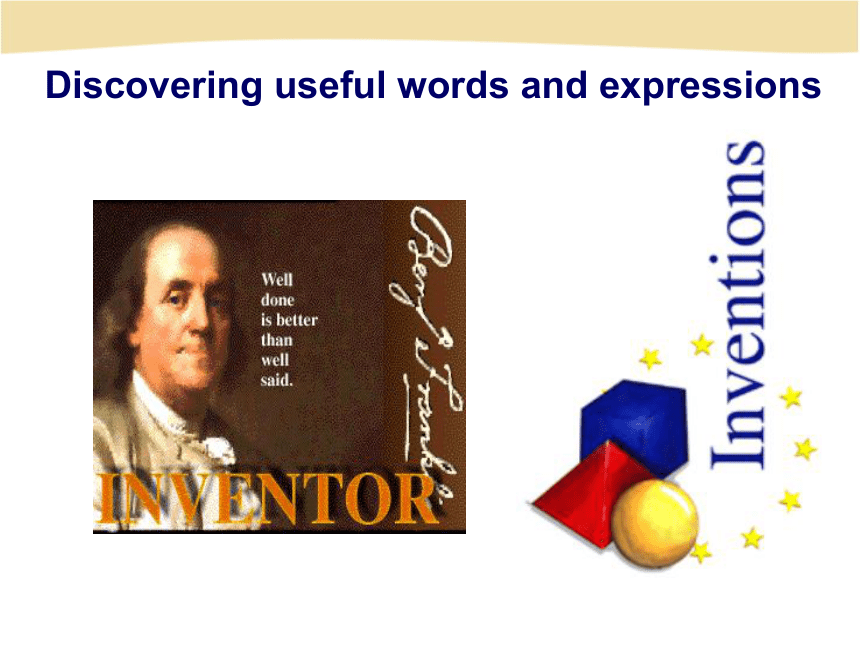
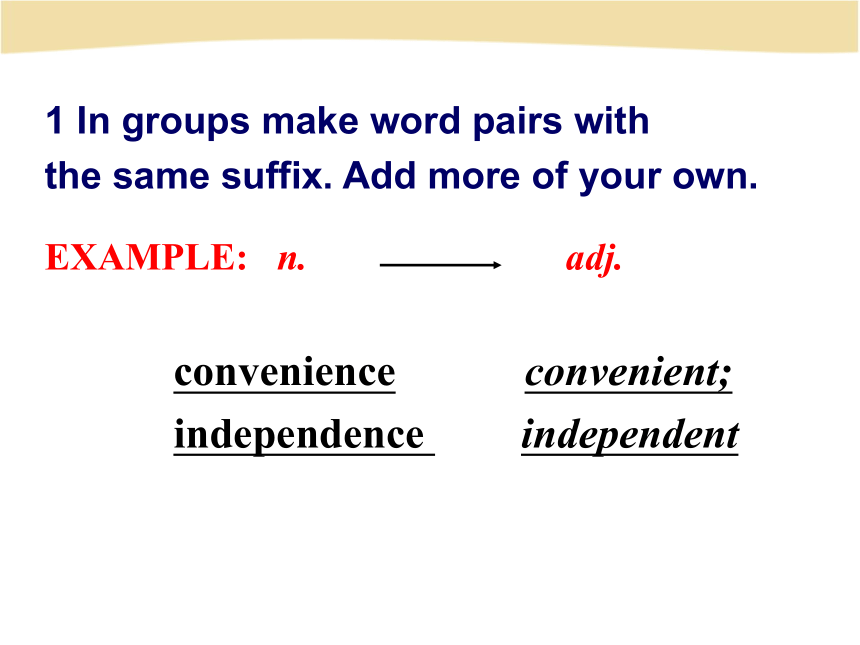
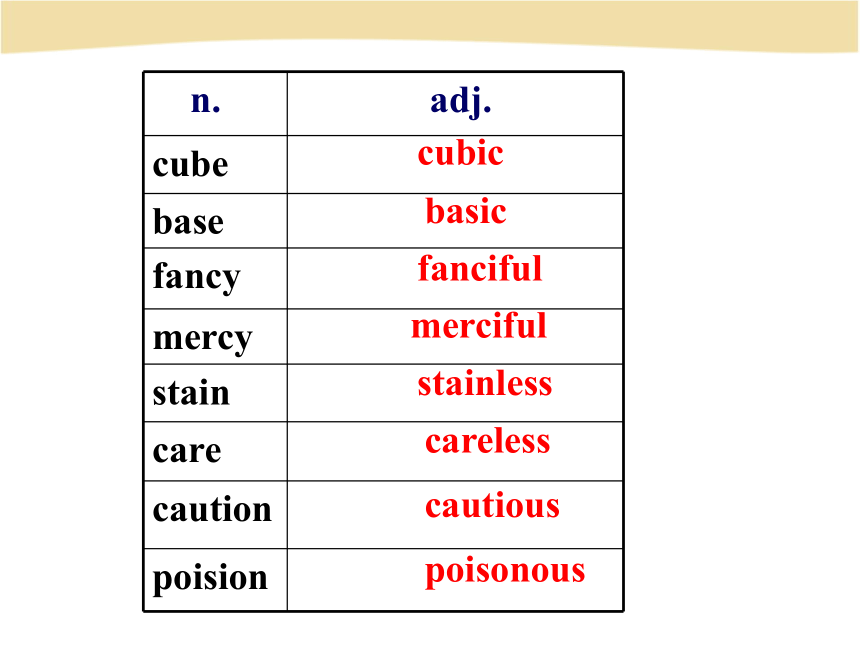
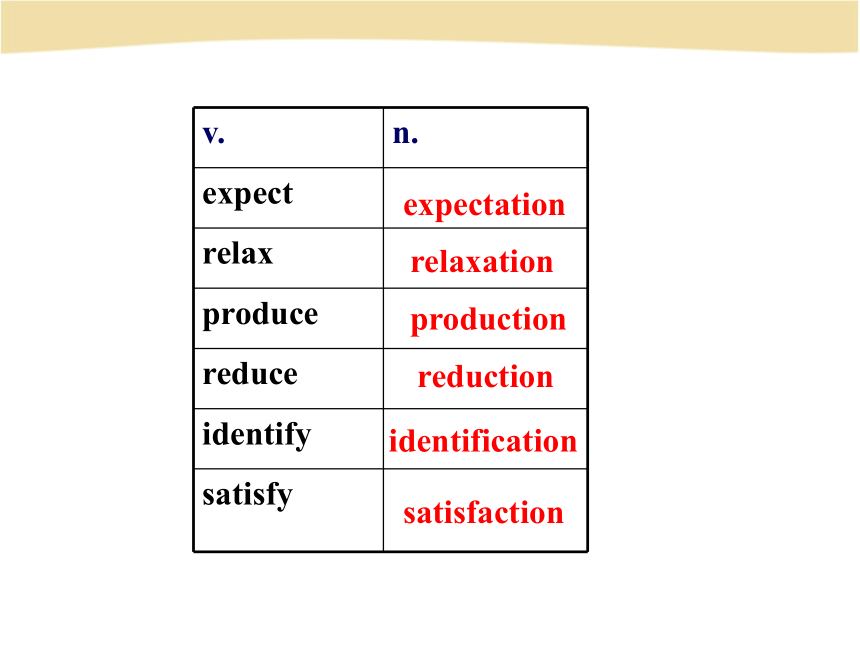
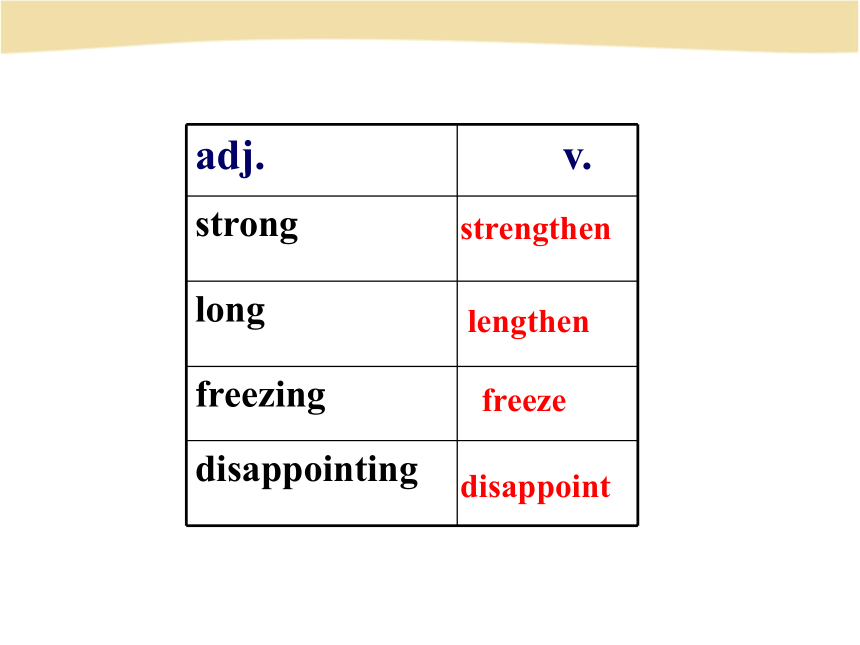
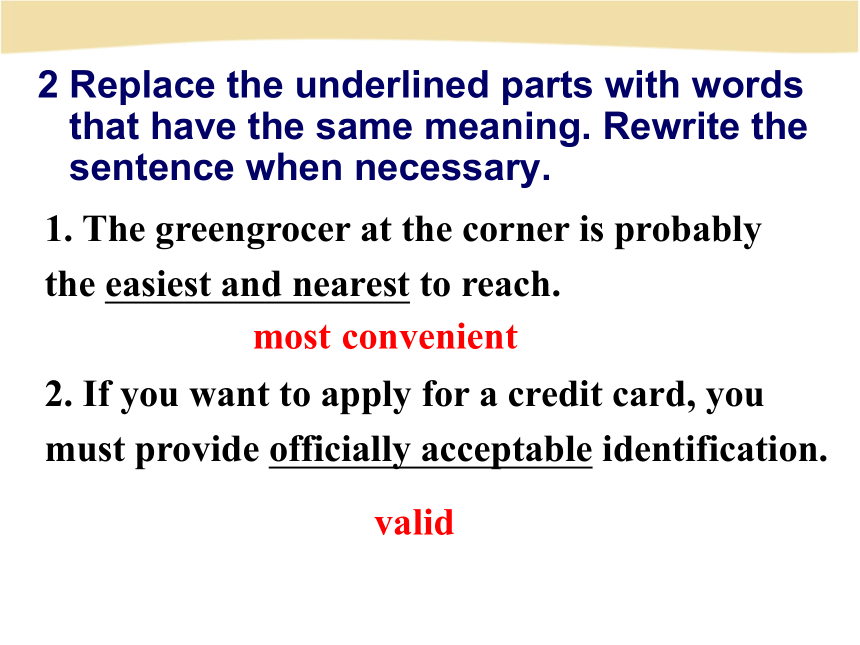
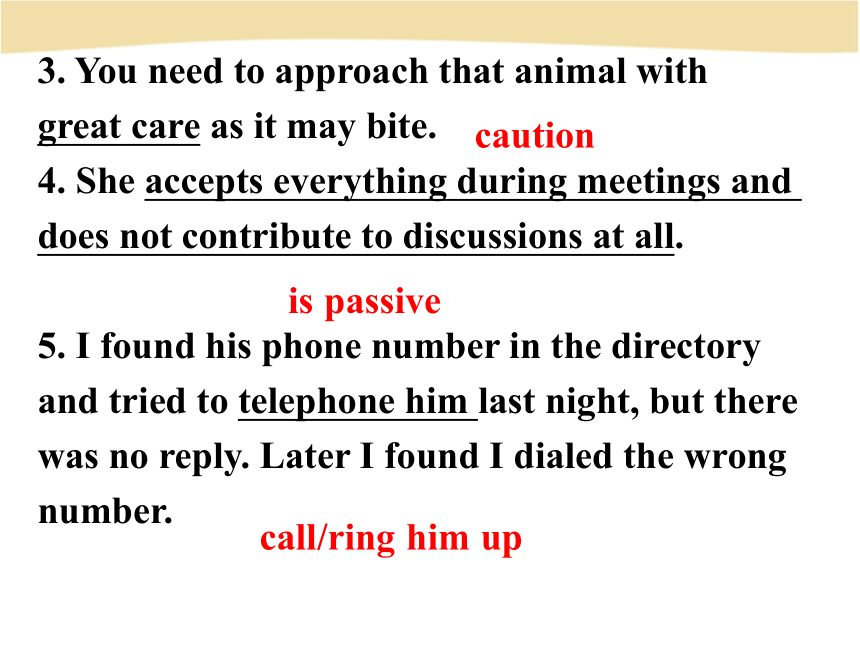
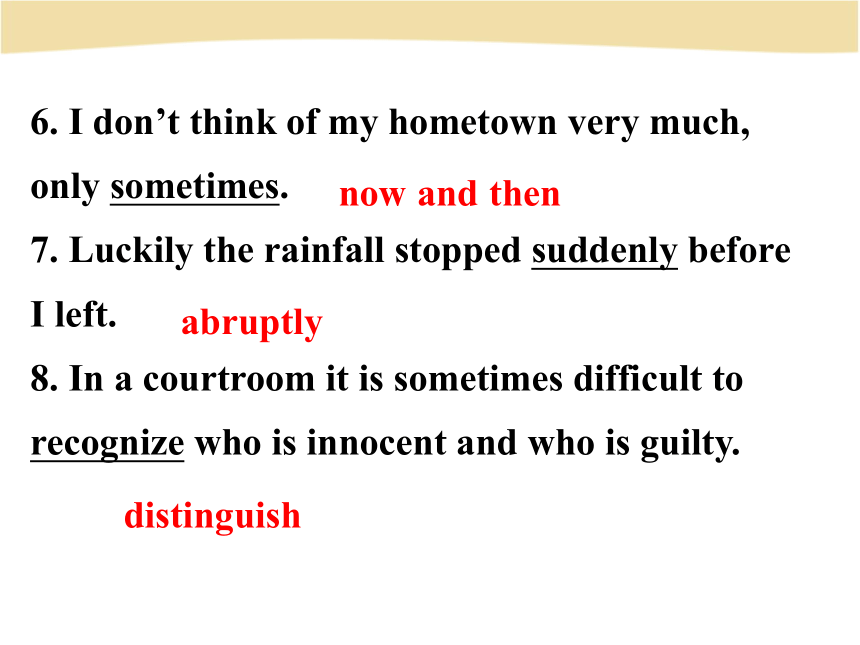
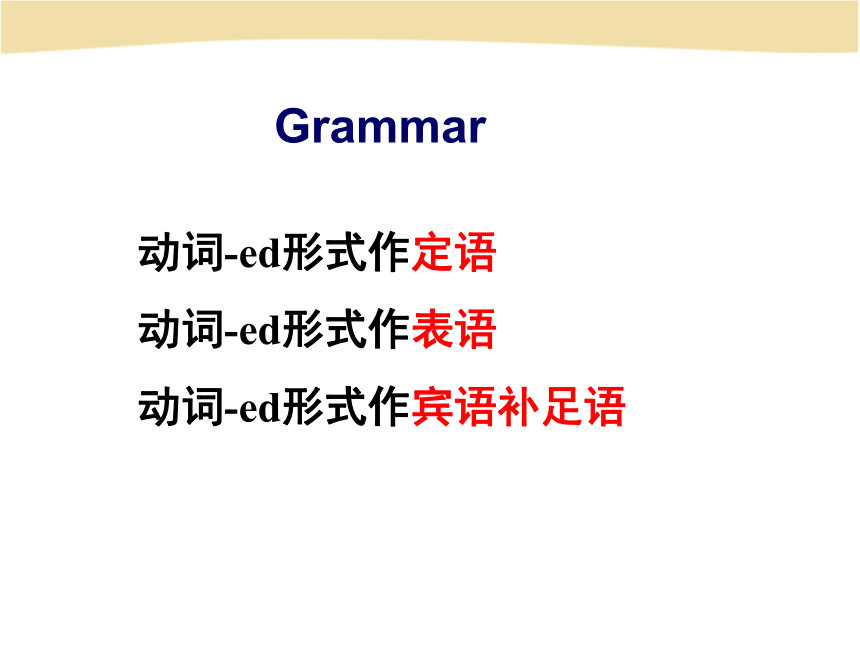
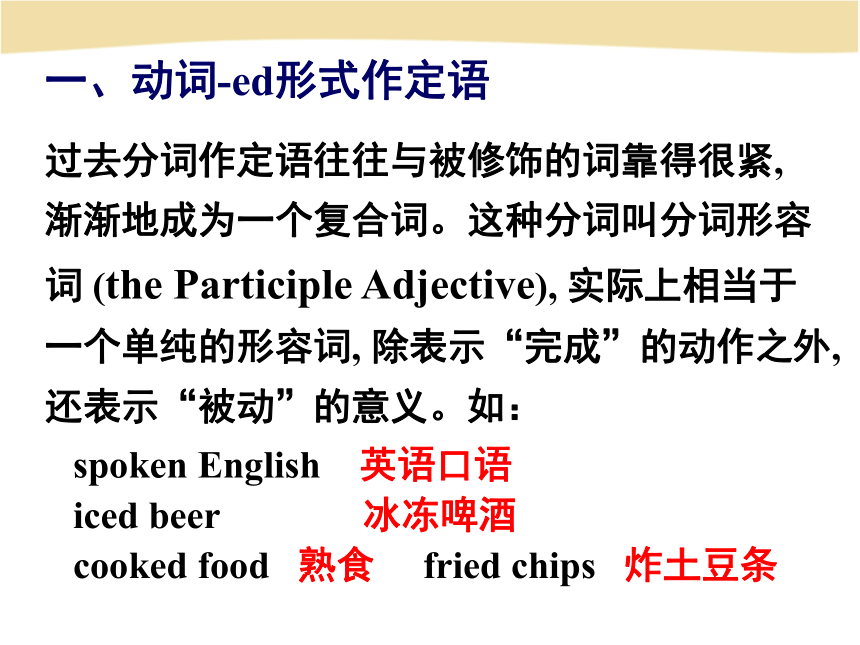
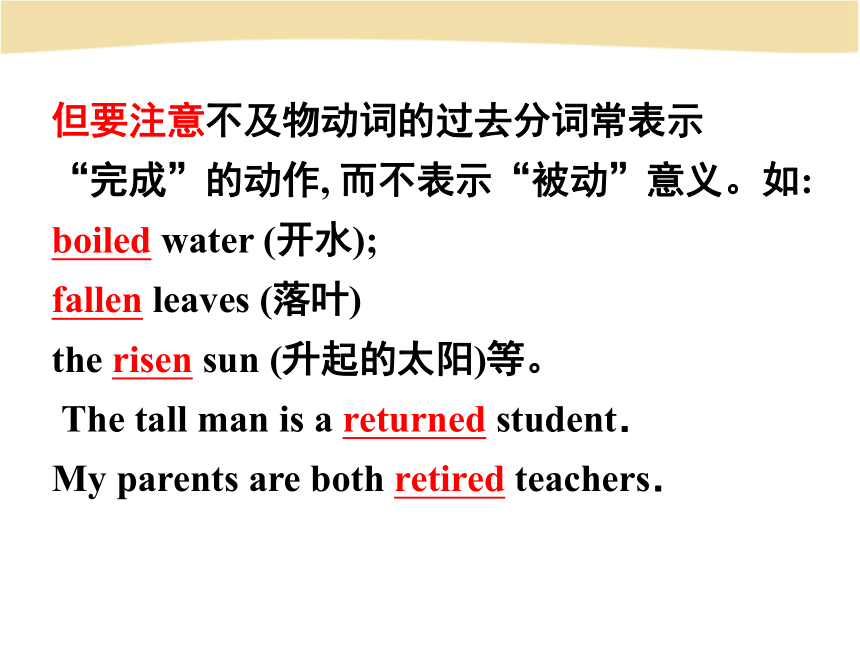
文档简介
课件41张PPT。Unit 3
Inventors and inventionsLearning about Language 选修八Discovering useful words and expressions EXAMPLE: n. adj.
convenience convenient;
independence independent In groups make word pairs with
the same suffix. Add more of your own. cubicbasicfancifulmercifulstainlesscarelesscautiouspoisonousexpectationrelaxationproductionreductionidentificationsatisfactionstrengthenlengthenfreezedisappoint2 Replace the underlined parts with words
that have the same meaning. Rewrite the
sentence when necessary. 1. The greengrocer at the corner is probably
the easiest and nearest to reach.
2. If you want to apply for a credit card, you
must provide officially acceptable identification. most convenientvalid3. You need to approach that animal with
great care as it may bite.
4. She accepts everything during meetings and
does not contribute to discussions at all.
5. I found his phone number in the directory
and tried to telephone him last night, but there
was no reply. Later I found I dialed the wrong
number. cautionis passivecall/ring him up6. I don’t think of my hometown very much,
only sometimes.
7. Luckily the rainfall stopped suddenly before
I left.
8. In a courtroom it is sometimes difficult to
recognize who is innocent and who is guilty.now and thenabruptlydistinguishGrammar动词-ed形式作定语
动词-ed形式作表语
动词-ed形式作宾语补足语过去分词作定语往往与被修饰的词靠得很紧,
渐渐地成为一个复合词。这种分词叫分词形容
词 (the Participle Adjective), 实际上相当于
一个单纯的形容词, 除表示“完成”的动作之外,
还表示“被动”的意义。如:一、动词-ed形式作定语 spoken English 英语口语
iced beer 冰冻啤酒
cooked food 熟食 fried chips 炸土豆条但要注意不及物动词的过去分词常表示
“完成”的动作, 而不表示“被动”意义。如:
boiled water (开水);
fallen leaves (落叶)
the risen sun (升起的太阳)等。
The tall man is a returned student.
My parents are both retired teachers.
(1) 前置定语单个的动词-ed形式, 一般放在被修饰
的名词的前面, 作前置定语。The excited people rushed into the building.(=the people who were excited)Lost time can never be found again.(=time which is lost) The books left are for my students. (2) 后置定语①少数单个动词的-ed形式, 如left等, 只能
作后置定语。剩下的书是给我的学生的。 ② 动词-ed形式短语作定语时, 通常要放在
被修饰的名词的后面, 在意思上相当于
一个定语从句。Is there anything planned for tonight?(= that has been planned for tonight)今晚有什么活动吗?The meeting, attended by a lot of people,
was a success.这次会议有很多人出席,开得很成功。 (=which was attended by a lot of people) 高考链接Most of the artists _____ to the party were
from South Africa.
A. invited B. to invite
C. being invited D. had been invited
2) The first text books _____ for teaching
English as a foreign language came out in
the 16th century.
A. having written B. to be written
C. being written D. writtenA D 3) The Olympic games, _______ in 776 BC,
didn’t include women players until 1912.
A. first playing B. to be first played
C. first played D. to be first playing
4) Prices of daily foods ______ through a
computer can be lower than prices in stores.
A. are bought B. bought
C. been bought D. buyingC B 5) Mr. Smith, ____ of the speech, started
to read an ____ novel.
A. tired, interesting
B. tiring, interested
C. tired, interested
D. tiring, interestingA 过去分词作表语并无“完成”或“被动”
之意, 而是表示主语的状态或思想感情等。
如:
He looked worried after reading the letter.
看完信后,他显得很忧虑。
When we heard of it, we were deeply moved.
当我们听到这件事时,被深深地感动了。
He seemed quite delighted at the idea.
听到这个想法,他似乎很高兴。 二、动词-ed形式作表语 I was very pleased at the news.
听了这消息我很高兴。
He grew much tired of the work.
他十分厌倦这工作。
She seemed quite excited when hearing
that she had passed the English test. 作表语的-ed形式可被much, very, quite
等所修饰。 Cleaning women in big cities usually
get ____ by the hour.
A. pay B. paying
C. paid D. to pay
2) As we joined the big crowd I got ____
from my friends.
A. separated B. spared
C. lost D. missed高考链接C C 3) The pilot asked all the passengers on
board to remain ____ as the plane was
making a landing
A. seat B. seating
C. seated D. to be seating C 三、动词-ed形式作宾语补足语 能用作宾语补足语的过去分词一般都是
及物动词,表示被动意义或已完成意义,
有时候两者兼而有之。作宾语补足语的
过去分词与宾语有逻辑上的动宾关系,
即宾语是过去分词动作的对象。She found the door broken in when she
came back.
她回来时发现有人破门而人。
My grandfather had his old house rebuilt.
我爷爷找人重修了一下他的旧房子。动词-ed形式作宾语补足语的基本用法
动词的-ed形式可以在“主语+谓语+宾语
+宾语补足语”句型中充当宾语补足语。在
这一结构中, 动词-ed形式和它前面的宾语
构成逻辑上的被动关系。如果这种句子改
为被动语态, 原来的宾语补足语变成了主语
补足语。People found the girl beaten black and blue.人们发现这个女孩被打得青一块紫一块。(宾语补足语)The girl was found beaten black and blue.(主语补足语) (1)动词-ed形式可作表示感觉和心理状态的
动词的宾语补足语,这类动词包括see, hear,
watch, notice, feel, find, think, suppose,
consider等。1. We thought the game lost.
我们认为球赛输了。2. I have never heard him spoken ill of others.
我从未听过有人说他的坏话。
3. She felt a great weight taken off her mind.
她觉得心里轻松了些。
4. They considered the matter settled.
他们认为这问题解决了。I have my hair cut once a month.
我每个月理一次发。
He was trying to make himself understood.
他正努力使别人听懂自己。
She held her hands pressed against her face.
她用双手按着脸。(2) 动词-ed形式可作使役动词的宾语补足语,
这类动词包括make, get, have, keep, leave,
hold等。She had her house repaired.
她请人把屋子修好了。
Where did you have your hair cut?
你在哪儿理的发? “have+宾语+done”结构有三个含义:① (请人)把某事做完。He had his hat blown away on his way
home.在回家的路上他的帽子被吹掉了。
She had her wallet stolen yesterday.
昨天她的钱包被偷了。② 遭遇某种意外情况。I have had all my spelling mistakes
corrected.
我把所有的拼写错误都改正了。
He has had one thousand yuan saved
this year.他今年已存了1000元。 ③ 完成某事 (自己也可能参与)。The thief was brought in with his hands tied
behind his back.小偷被带进来了, 双手被反绑在后面。(4) 过去分词用在“with+宾语+宾补”这一结构中, 过去分词与宾语之间是动宾关系。You can make yourself ____ in English pretty
well if you keep on speaking the language.
A. understand B. understanding
C. to understand D. understood
2. -- There is a hole in your bag.
-- I know. I’m going to have it ______.
A. mend B. mending
C. mended D. to be mended Practice D C 3. --How do you deal with the disagreement
between the company and the customers?
--The key ______ the problem is to meet the
demand _____ by the customers.
A. to solving; making B. to solving; made
C. to solve; making D. to solve; made
B 4. English is a language _____ all around the
world and is the _____ language of most
international organizations.
A. to speak, working
B. spoken, working
C. speaking, worked
D. spoken, workedB 5. He found a magazine _____ with the
owner’s name_____ on the desk with the
back cover _____ off.
A. marking, lying, torn
B. marked, lying, torn
C. marked, laid, tearing
D. marking, laying, tearingB For more exercises, click here.6. Can those ____ at the back of the
classroom hear me?
A. seat B. sit C. seated D. sat
7. The trees ____ in the storm have been
moved off the road.
A. being blown down B. blown down
C. blowing down D. to blow downC B 8. To learn English well, we should find
opportunities to hear English ______ as
much as we can.
A. speak. B. speaking
C. spoken D. to speak
9. We finished the run in less than half the
time _____.
A. allowing B. to allow
C. allowed D. allowsC C 10. It is one of the funniest things ____ on the
Internet so far this year.
A. finding B. being found
C. to find D. foundD Finish the exercises on grammar in
this unit.
2. Preview the reading materials in
Using Language.Homework
Inventors and inventionsLearning about Language 选修八Discovering useful words and expressions EXAMPLE: n. adj.
convenience convenient;
independence independent In groups make word pairs with
the same suffix. Add more of your own. cubicbasicfancifulmercifulstainlesscarelesscautiouspoisonousexpectationrelaxationproductionreductionidentificationsatisfactionstrengthenlengthenfreezedisappoint2 Replace the underlined parts with words
that have the same meaning. Rewrite the
sentence when necessary. 1. The greengrocer at the corner is probably
the easiest and nearest to reach.
2. If you want to apply for a credit card, you
must provide officially acceptable identification. most convenientvalid3. You need to approach that animal with
great care as it may bite.
4. She accepts everything during meetings and
does not contribute to discussions at all.
5. I found his phone number in the directory
and tried to telephone him last night, but there
was no reply. Later I found I dialed the wrong
number. cautionis passivecall/ring him up6. I don’t think of my hometown very much,
only sometimes.
7. Luckily the rainfall stopped suddenly before
I left.
8. In a courtroom it is sometimes difficult to
recognize who is innocent and who is guilty.now and thenabruptlydistinguishGrammar动词-ed形式作定语
动词-ed形式作表语
动词-ed形式作宾语补足语过去分词作定语往往与被修饰的词靠得很紧,
渐渐地成为一个复合词。这种分词叫分词形容
词 (the Participle Adjective), 实际上相当于
一个单纯的形容词, 除表示“完成”的动作之外,
还表示“被动”的意义。如:一、动词-ed形式作定语 spoken English 英语口语
iced beer 冰冻啤酒
cooked food 熟食 fried chips 炸土豆条但要注意不及物动词的过去分词常表示
“完成”的动作, 而不表示“被动”意义。如:
boiled water (开水);
fallen leaves (落叶)
the risen sun (升起的太阳)等。
The tall man is a returned student.
My parents are both retired teachers.
(1) 前置定语单个的动词-ed形式, 一般放在被修饰
的名词的前面, 作前置定语。The excited people rushed into the building.(=the people who were excited)Lost time can never be found again.(=time which is lost) The books left are for my students. (2) 后置定语①少数单个动词的-ed形式, 如left等, 只能
作后置定语。剩下的书是给我的学生的。 ② 动词-ed形式短语作定语时, 通常要放在
被修饰的名词的后面, 在意思上相当于
一个定语从句。Is there anything planned for tonight?(= that has been planned for tonight)今晚有什么活动吗?The meeting, attended by a lot of people,
was a success.这次会议有很多人出席,开得很成功。 (=which was attended by a lot of people) 高考链接Most of the artists _____ to the party were
from South Africa.
A. invited B. to invite
C. being invited D. had been invited
2) The first text books _____ for teaching
English as a foreign language came out in
the 16th century.
A. having written B. to be written
C. being written D. writtenA D 3) The Olympic games, _______ in 776 BC,
didn’t include women players until 1912.
A. first playing B. to be first played
C. first played D. to be first playing
4) Prices of daily foods ______ through a
computer can be lower than prices in stores.
A. are bought B. bought
C. been bought D. buyingC B 5) Mr. Smith, ____ of the speech, started
to read an ____ novel.
A. tired, interesting
B. tiring, interested
C. tired, interested
D. tiring, interestingA 过去分词作表语并无“完成”或“被动”
之意, 而是表示主语的状态或思想感情等。
如:
He looked worried after reading the letter.
看完信后,他显得很忧虑。
When we heard of it, we were deeply moved.
当我们听到这件事时,被深深地感动了。
He seemed quite delighted at the idea.
听到这个想法,他似乎很高兴。 二、动词-ed形式作表语 I was very pleased at the news.
听了这消息我很高兴。
He grew much tired of the work.
他十分厌倦这工作。
She seemed quite excited when hearing
that she had passed the English test. 作表语的-ed形式可被much, very, quite
等所修饰。 Cleaning women in big cities usually
get ____ by the hour.
A. pay B. paying
C. paid D. to pay
2) As we joined the big crowd I got ____
from my friends.
A. separated B. spared
C. lost D. missed高考链接C C 3) The pilot asked all the passengers on
board to remain ____ as the plane was
making a landing
A. seat B. seating
C. seated D. to be seating C 三、动词-ed形式作宾语补足语 能用作宾语补足语的过去分词一般都是
及物动词,表示被动意义或已完成意义,
有时候两者兼而有之。作宾语补足语的
过去分词与宾语有逻辑上的动宾关系,
即宾语是过去分词动作的对象。She found the door broken in when she
came back.
她回来时发现有人破门而人。
My grandfather had his old house rebuilt.
我爷爷找人重修了一下他的旧房子。动词-ed形式作宾语补足语的基本用法
动词的-ed形式可以在“主语+谓语+宾语
+宾语补足语”句型中充当宾语补足语。在
这一结构中, 动词-ed形式和它前面的宾语
构成逻辑上的被动关系。如果这种句子改
为被动语态, 原来的宾语补足语变成了主语
补足语。People found the girl beaten black and blue.人们发现这个女孩被打得青一块紫一块。(宾语补足语)The girl was found beaten black and blue.(主语补足语) (1)动词-ed形式可作表示感觉和心理状态的
动词的宾语补足语,这类动词包括see, hear,
watch, notice, feel, find, think, suppose,
consider等。1. We thought the game lost.
我们认为球赛输了。2. I have never heard him spoken ill of others.
我从未听过有人说他的坏话。
3. She felt a great weight taken off her mind.
她觉得心里轻松了些。
4. They considered the matter settled.
他们认为这问题解决了。I have my hair cut once a month.
我每个月理一次发。
He was trying to make himself understood.
他正努力使别人听懂自己。
She held her hands pressed against her face.
她用双手按着脸。(2) 动词-ed形式可作使役动词的宾语补足语,
这类动词包括make, get, have, keep, leave,
hold等。She had her house repaired.
她请人把屋子修好了。
Where did you have your hair cut?
你在哪儿理的发? “have+宾语+done”结构有三个含义:① (请人)把某事做完。He had his hat blown away on his way
home.在回家的路上他的帽子被吹掉了。
She had her wallet stolen yesterday.
昨天她的钱包被偷了。② 遭遇某种意外情况。I have had all my spelling mistakes
corrected.
我把所有的拼写错误都改正了。
He has had one thousand yuan saved
this year.他今年已存了1000元。 ③ 完成某事 (自己也可能参与)。The thief was brought in with his hands tied
behind his back.小偷被带进来了, 双手被反绑在后面。(4) 过去分词用在“with+宾语+宾补”这一结构中, 过去分词与宾语之间是动宾关系。You can make yourself ____ in English pretty
well if you keep on speaking the language.
A. understand B. understanding
C. to understand D. understood
2. -- There is a hole in your bag.
-- I know. I’m going to have it ______.
A. mend B. mending
C. mended D. to be mended Practice D C 3. --How do you deal with the disagreement
between the company and the customers?
--The key ______ the problem is to meet the
demand _____ by the customers.
A. to solving; making B. to solving; made
C. to solve; making D. to solve; made
B 4. English is a language _____ all around the
world and is the _____ language of most
international organizations.
A. to speak, working
B. spoken, working
C. speaking, worked
D. spoken, workedB 5. He found a magazine _____ with the
owner’s name_____ on the desk with the
back cover _____ off.
A. marking, lying, torn
B. marked, lying, torn
C. marked, laid, tearing
D. marking, laying, tearingB For more exercises, click here.6. Can those ____ at the back of the
classroom hear me?
A. seat B. sit C. seated D. sat
7. The trees ____ in the storm have been
moved off the road.
A. being blown down B. blown down
C. blowing down D. to blow downC B 8. To learn English well, we should find
opportunities to hear English ______ as
much as we can.
A. speak. B. speaking
C. spoken D. to speak
9. We finished the run in less than half the
time _____.
A. allowing B. to allow
C. allowed D. allowsC C 10. It is one of the funniest things ____ on the
Internet so far this year.
A. finding B. being found
C. to find D. foundD Finish the exercises on grammar in
this unit.
2. Preview the reading materials in
Using Language.Homework
